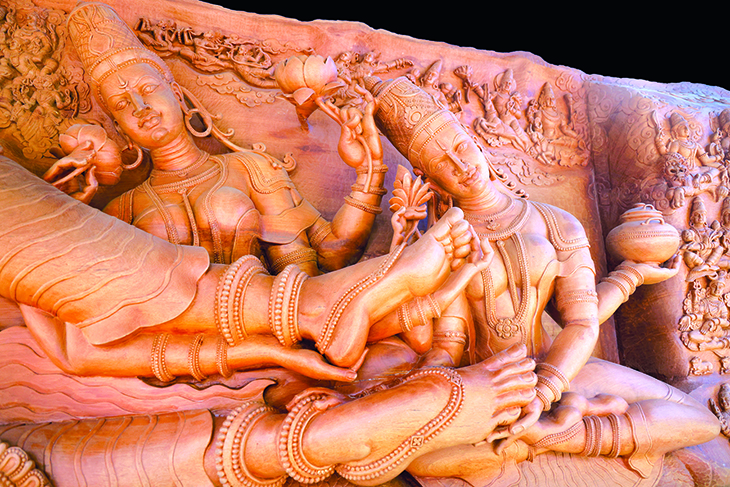Myanmar log unveils a Vishnu masterpiece

The sculpture of Mahavishnu is accompanied by Bhoodevi and Sridevi.
In the heart of Secunderabad (Telangana), an exceptional ekandi (single log) sculpture of the reclining Vishnu (Anantha-Seshashayana Shri Mahavishnu) has become a focal point of admiration since its public revelation in July last year.
Consecrated by the former Vice-President of India, M. Venkaiah Naidu, this remarkable sculpture is a testament to the intersection of excellent artisanship, woodworking finesse, rich Indian history and unwavering dedication of a bunch of wood artisans from Andhra Pradesh, Tamil Nadu and Myanmar (erstwhile Burma)!
Crafted with precision from a single teak log that had weathered centuries in the remote forests of Myanmar, the sculpture’s origins trace back about 1,500 years.
Weighing a colossal 3.5 tonnes, measuring 21 feet in length, 8.6 feet in height and 20 feet in girth (circumference), this masterpiece is a true marvel. The Burma teak, sourced from the world’s largest teak tree, adds to its significance.
Vision realised
At the helm of this visionary endeavour is Sharath Babu Chadalavada, the Managing Partner at Secunderabad-based Anuradha Timbers International. The enormous log was first sourced in 2017 by him from a timber depot in Myanmar.
With business connections spanning 40 countries, Sharat’s vision turned the Myanmar government-auctioned log into an awe-inspiring sculpture.
The company’s past projects include prestigious works for spiritual leaders and royalty, luxury yachts of the uber-rich, and wood-based projects like the old Parliament library in New Delhi.
The sculpture of Mahavishnu, accompanied by Bhoodevi, Sridevi and the celestial serpent, Adisheshu, boasts life-like replication of skin, jewellery, hand and foot contours, and even nails.
Meticulously carved, the woodwork is exceptionally smooth, free of visible wood grain or nodes. Beyond the central figure, the sculpture features 84 additional intricately carved sculptures, each contributing to the overall grandeur.
The fact that this variety of Myanmar wooden logs have no sap, possess natural oil, and have very low moisture content also made this dream a practical possibility, says Sharath.
Overcoming hurdles
Sharath Babu was determined that the log should remain unbroken and the shape unchanged as far as possible. He realised that the log shape was amenable to a reclining figure; and finally, the central area was such that it could easily be shaped into a hip.
Valuable inputs were taken from Vedic pandits and from temple construction experts like Sthapathi Kumaraswamy and other woodworking professionals. The whole project was finally given shape by artist Rayana Giridhara Gowd.
The journey from a Myanmar forest to an office in Secunderabad was riddled with challenges. With Myanmar’s regulations prohibiting the export of logs in this form, Sharath navigated bureaucratic obstacles, sought permission, and eventually transformed the colossal log into a breathtaking sculpture.
A team of sculptors from Mahabalipuram (Tamil Nadu) and skilled artisans from a Myanmar village worked tirelessly under the watchful eyes of Anuradha Timbers International. About 40% of the work was completed in Myanmar and the balance after it was moved it to India.
It is evident that this endeavour goes beyond commercial pursuits. When asked about the future of the Mahavishnu sculpture, Sharath Babu cryptically states, “It was not made for commercial purposes.”
The Ananthaseshashayana Shri Mahavishnumurthy sculpture is not only a magnificent work of art but stands as a testament to human determination, cultural preservation, and a harmonious blend of craftsmanship and spirituality.

The celestial (L) and earth-bound (R) figures come from inspiration from Vedic texts dating back 1,500 years.
Comments

- Myanmar log unveils a Vishnu masterpiece
- IndiaWood 2024: Amplifying opportunities, manufacturing innovation
- Greenlam releasing new plywood collection
- Hettich will unveil ‘Magic Lights’ collection
- SCM is presenting cutting-edge solutions
- Woodtech’s state-of-the-art machines to make their debut
- E-Chain’s tenoner reduces downtime
- Goodtek planer is suitable for wood, non-metals
- Special edge profiling machines from Technik
- Italian accessories from Utturkar’s
- Dieffenbacher smart-tunes production efficiency
- Holytek to showcase rip saw, planer
- IPCO’s world-class steel belts for the WBP industry
- Yow Cherng machines offer quality and value
- TWMA steps into smart woodworking
- Customised cutters from Tong Fong
- Richfill introducing Edge Coat
- Cutting-edge, multi-shaft products from Wen Chih
- Ebco to showcase the latest in LED lights
- Lumber without cutting trees?
- Ligna on cusp of its golden jubilee
- Steel flakes add value to wood paints
- Leitz India now global production hub
- Homing in… Impressions from IndiaWood
- Felder India launches two new machines
- Japan’s Shoda unveils dust-free CNC router
- Luigi de Vito: Look forward to ‘Industry 5.0’
- Merino: Future of chipboard is here!
- Biesse poised for growth: locally, globally
- Piergiorgio Pozzo on ‘dynamic’ saw blade balance
- Dürr’s new paint supply system cuts losses
- Hafele unveils One-Touch mechanism
- Optimus and Modula range are best-in-class
- Katana sawblades slash cutting costs
- Woodtech’s top door-making solutions
- Canadian Wood celebrates World Wood Day
- Hanoi Expo to open in May
- Interzum adds Forum in Bergmano, Italy
- Pidilite Ventures launches ‘Building Bonds’
- Events Calendar
- Xylexpo opens for 4 days in May
- Glass bricks for structural walls?
- Climate partnership bats for wood in construction
- IKEA cuts CO2 footprint 12%
- Cefla aids innovation for Portuguese panel maker
- Lamello’s small efforts have big effect
- Rehau focuses on expansion, design excellence
- Leuco tools to enter India market
- Record year for US hardwood exports to India
- Andritz partners with Indian panelboard producers
- Versatile wood species from Canada
- CMT introduces DPX blades for beam saws
- Strong panels from agri waste
- Greenlam innovations grab industry recognition at Indiawood
- IKEA launches office furniture range
- SMEs given time to prepare for QCO
- Weinig buys grinding machine unit
- China’s wooden furniture exports decline
- Melanie Bockemühl joins Siempelkamp
- Dieffenbacher supplies another Cebro plant
- SawStop to release patented technology
- Blum opens new centre in Bengaluru
- EuroTech Vertriebs is now EuroTech Handling
- Park Hotels unveils novel design concept
- Siempelkamp acquires Febs SK
- Australian Panels orders new MDF line
- HNI Office opens in Hyderabad
- Venus launches design platform
- Koelnmesse plans new cooperations in Asia
- Revolutionary acrylic boards from Decolam
- Formica makes a formidable presence
- Hafele demonstrates the value of space
- Hettich’s Magic Lights is a design philosophy
- Special ‘thali’ storage from Utturkar’s
- IPCO reports excellent response
- Jai delights with several solutions
- Atemag expands CNC machining possibilities
- Italy’s SCM ready with Indian subsidiary
- Altendorf showcases top-line panel saws, edge banding machines
- Berndorf steel belts represent cutting-edge technology
- Fiamarc elevates interiors with Frontaline glass fittings
- How to go digital with design, manufacturing
- Ozone showcases its diverse range
- Unipegasus introduces interior décor range
- Stela deploys cutting-edge drying tech
- High-quality adhesives from Unicol
- Woodtech launches 3 versatile machines






































